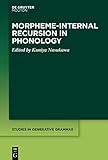Morpheme-internal Recursion in Phonology / ed. by Kuniya Nasukawa.
Material type: TextSeries: Studies in Generative Grammar [SGG] ; 140Publisher: Berlin ; Boston : De Gruyter Mouton, [2020]Copyright date: ©2020Description: 1 online resource (IX, 415 p.)Content type:
TextSeries: Studies in Generative Grammar [SGG] ; 140Publisher: Berlin ; Boston : De Gruyter Mouton, [2020]Copyright date: ©2020Description: 1 online resource (IX, 415 p.)Content type: - 9781501517778
- 9781501512414
- 9781501512582
- 415 23
- P293.38 .M677 2020
- online - DeGruyter
- Issued also in print.
| Item type | Current library | Call number | URL | Status | Notes | Barcode | |
|---|---|---|---|---|---|---|---|
 eBook
eBook
|
Biblioteca "Angelicum" Pont. Univ. S.Tommaso d'Aquino Nuvola online | online - DeGruyter (Browse shelf(Opens below)) | Online access | Not for loan (Accesso limitato) | Accesso per gli utenti autorizzati / Access for authorized users | (dgr)9781501512582 |
Frontmatter -- Contents -- List of Contributors -- Introduction -- Recursion in melodic-prosodic structure -- A theory of the theory of vowels -- On some deep structural analogies between syntax and phonology -- Decomposition and recursive structure: Glide formation and vowel lowering in East Asian languages -- Multi-layered recursive representations for depressors -- Embedding of the same type in phonology -- Velar softening without precedence relations -- Recursion and GP 2.0 -- Head, dependent, or both: Dependency relations in vowels -- Defining recursive entities in phonology: The Onset Prominence framework -- Obstruent liquid clusters: Locality, projections and percolation -- Recursive strong assignment from phonology to syntax -- Language Index -- Subject Index
restricted access online access with authorization star
http://purl.org/coar/access_right/c_16ec
Generative phonology aims to formalise two distinct aspects of phonological processes: the functional and the representational. Since functions operate on representations, it is clear that the functional aspect is influenced by the form of representations, i.e. different types of representation require different types of rules, principles or constraints. This volume examines the representational issue in phonology and considers what kind of representation is most appropriate for recent models of generative phonology. In particular, it provides the first platform for debate on the place of morpheme-internal structure and on the formal status of phonology in the language faculty, and attempts to identify phonological recursive structure as a means of capturing frequently observed processes.
Issued also in print.
Mode of access: Internet via World Wide Web.
In English.
Description based on online resource; title from PDF title page (publisher's Web site, viewed 25. Jun 2024)


